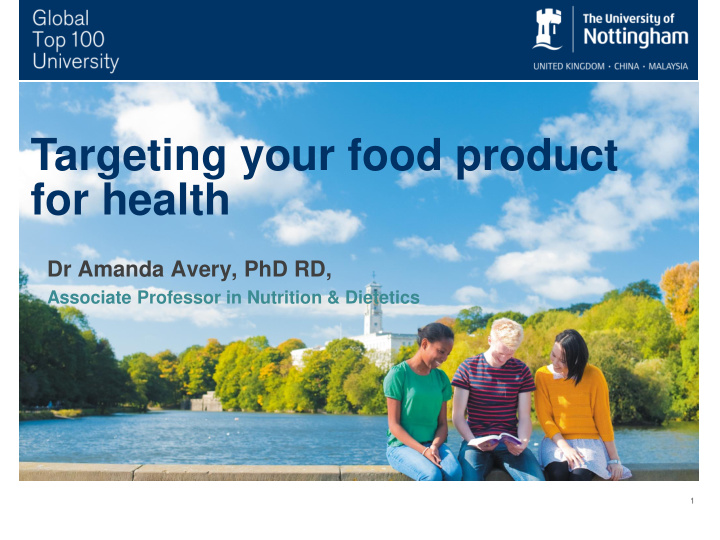



Targeting your food product for health Dr Amanda Avery, PhD RD, Associate Professor in Nutrition & Dietetics 1 1
Where do you want your product to fit? 1. To help the general public achieve healthy eating guidelines (informed by our knowledge of how the current UK diet falls short) (eg. reformulating foods to reduce fat/ reduce sugar / reduce salt/ increase fibre content or through fortification). Thus promoting better health. 2. To help a group who find it difficult to achieve a normal dietary target but who do not have a specific clinical condition (eg. toddlers and iron; older people and a nutrient dense diet) 3. Foods targeting a specific clinical group (eg. gluten free, nut free, CMP free, modified texture, low CHO/ high protein) 2
Where do you want your product to fit? 4) In a ‘niche’ market 5) As a functional food or as a sustainable food product which will ‘help to meet the challenge of providing the world's growing population with access to safe, affordable and nutritious food, all of the time and in ways the planet can sustain into the future’ . 3
1)To help the general public achieve healthy eating guidelines Rec’d men women Lives saved/yr Total fat (%) 35.8 34.9 35 Saturated fat 13.4 13.2 11 3,500 (%) NMES (%) 13.6 11.9 11 3,500 Free sugars 5 (%) Trans fats (%) 1 1 Salt (g) 10.2 7.6 6 Dietary fibre 13.7 13.9 30 (g) 4
Where do you want your product to fit? or as a sustainable food product which will ‘help to meet the challenge of providing the world's growing population with access to safe, affordable and nutritious food, all of the time and in ways the planet can sustain into the future’ . 5
Challenges of recipe reformulation • Salt has a preservative effect – by reducing the salt in ham from 3.7 to 1.9% the time taken for an observable increase in C.botulinium falls from 22 to 9 days • Amount of salt in bread can influence dough ‘stickiness’ • Fat substitutes can affect the water available to micro- organisms. Some substitutes may influence product pH. • Unsaturated fat is more easily oxidised than saturated fat. • To find the right substitute which improves the overall nutritional profile and does no harm. 6
2)To help a group who find it difficult to achieve an optimal nutritional intake Infants/toddlers - dietary problems arise due to poor practices when solids are introduced (also drinking habits) Children/ adolescents - poor calcium/vitamin D intakes; too much sugar and foods with a low nutritional content Pregnant women - ditto; vulnerable to excess weight gain Women/Men - obesity, prediabetes/T2D; sarcopenia Older people – dysphagia, dementia, undernutrition But better than special products is to encourage healthier family eating practices 7
3)Foods targeting a specific clinical group Coeliac disease - an autoimmune inflammatory condition of the small intestine caused by the ingestion of gluten. Treatment is life-long adherence to a gluten free diet. Food allergy - certain antibodies respond abnormally to allergens – usually proteins eg cows milk protein, nuts, eggs, soya. The response can be immediate or delayed and the level of severity variable. Enzyme deficiencies eg lactase But better than special products is to encourage healthier family eating practices with normal foods where possible and to avoid deficiencies! 8
4) In a niche market Sports nutrition - an optimal diet assists the athlete to maximize training and competition performance whilst maintaining good health. Good hydration is very important; CHO & protein need to be adequate. Vegetarian/Vegan diets – need for alternative protein sources eg nuts, legumes, pulses, soya The young busy professional? But better than special products is to encourage healthier family eating practices with normal foods where possible and to avoid deficiencies! 9
5) As a functional food ( when consumed regularly, as part of the usual diet, have beneficial health effects over and above their basic nutritional value ). They can be ; A natural food A food with a component added A food with a component removed A food where one or more components are modified A food in which the bioavailability has been modified Any combination of the above Eg dairy spreads with plant sterols and stanols; omega 3 enriched eggs, foods with added beta-glucan. Currently cannot include foods where prebiotics or probiotics have been added. 10
Or do you want to save the world from starvation? Alternative protein sources. Less processed foods Foods made from locally sourced, seasonal ingredients Reduce food wastage Water will be a limiting factor going forward Packaging 11
Questions? Amanda.avery@nottingham.ac.uk 12 12
Recommend
More recommend